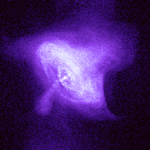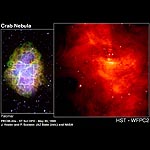Crab Nebula in Context
 X-ray image of Crab Nebula
NASA/CXC/SAO X-ray image of Crab Nebula
NASA/CXC/SAO
|
Neutron stars are extremely dense, with a mass slightly greater than the Sun compressed into a sphere only 20 km across. The strong gravity of the star packs the neutrons in its core more tightly than neutrons are packed in the nucleus of an atom.
Every 33 milliseconds the neutron star in the Crab spins one full revolution. This means that a point on the equator of the neutron star travels at roughly 4 million miles per hour. The star was spun up when it collapsed from a normal, large and relatively slowly rotating, star down to the compact size of the neutron star. The effect is the same as when a twirling ice skater pulls in her arms and spins faster.
 Hubble Space Telescope optical
image of inner part of Crab Nebula Hubble Space Telescope optical
image of inner part of Crab Nebula
|
The neutron star's rapid rotation (30 times/second) powers the
radiation we see from the Crab pulsar and the nebula. The
neutron star has a strong magnetic field, 10 trillion times as
strong as the magnetic field of the Earth. Because the star is
rotating, the magnetic field acts like a gigantic electric power
generator. The Crab neutron star produces a total power output
equal to 100,000 times the power output by the Sun. Generating
this power gradually slows down the pulsar; the period of
rotation of the Crab pulsar is increasing by 15 microseconds per
year.
This stellar dynamo also produces a wind of electrons and
positrons, the anti-matter partner of the electrons. The
positrons are created in the intense electrical fields of the
generator at a rate of 10^37 positrons per second. The electrons
and positrons flow out from the Crab at close to the speed of
light and energies up to at least one trillion electron
volts.
There are approximately 1000 known pulsars and the number increases almost
daily. Most are discovered by radio observations. The Crab is one of the
youngest and most energetic pulsars known. A few dozen pulsars are also
seen to pulse in X-rays and six are seen to pulse in gamma-rays. The Crab
has been seen to pulse in almost every wavelength, in radio, optical, X-rays,
and gamma-rays. The nebula is also visible over this broad range of wavelengths.
Return to Crab Nebula (28
Sep 99)


